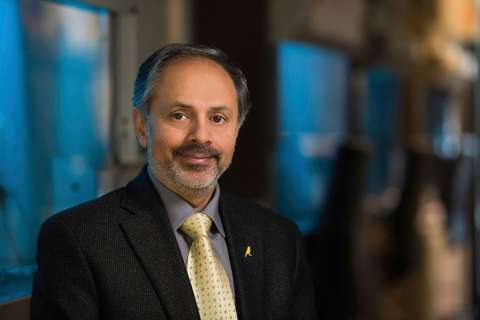Two researchers from the UCLA Stein Eye Institute have been selected for the Foundation for the National Institutes of Health (FNIH) Accelerating Medicines Partnership® Bespoke Gene Therapy Consortium (AMP® BGTC), a public-private partnership that seeks to accelerate the development and delivery of customized gene therapies for rare diseases. Funding provided by the California Institute for Regenerative Medicine (CIRM), gene therapy subject matter resources and expertise from the Consortium will help researchers develop a gene therapy for infants and children with congenital hereditary endothelial dystrophy (CHED), a condition that causes corneal clouding and poor vision from birth.
The announcement was made on May 16 during the American Society of Gene & Cell Therapy (ASGCT) 26th Annual Meeting.
Prior to initiation of the human clinical trial, UCLA Health scientists Dr. Wenlin Zhang and Dr. Anthony Aldave, professor of ophthalmology and Walton Li Chair in Cornea and Uveitis at the David Geffen School of Medicine at UCLA, will determine the optimal dosing and delivery of gene therapy via injection into the cornea to correct the genetic defect in the endothelial cells of the cornea – the cells primarily affected in CHED.
“I very much look forward to working with the entire AMP® BGTC team to advance this noble cause in expanding the reach of gene therapy to the rare disease community,” said Dr. Wenlin Zhang. “Working in the rare disease field has been tough to say the least, and I really hope that what AMP® BGTC is doing can raise the awareness and recognition that research in this field not only benefits patients with rare conditions, but can be translated to treat patients with more prevalent diseases.”
“Currently, we have no effective pharmaceutical treatment for CHED and thus corneal transplantation is the only treatment option,” said Dr. Anthony Aldave. “Using an injectable gene therapy to avoid corneal transplantation in infants and children, which is associated with an increased risk of intraoperative and postoperative complications, including higher rates of transplant rejection and failure, will improve the quality of life of these young patients and their families.
CHED is an inherited disease causing corneal clouding presenting at birth or in the first decade of life. On average, transplanted corneas in patients with CHED remain clear for only approximately 10 years. As a result, multiple corneal transplants are needed throughout the lifetime of an affected individual, with increasing complication rates and decreasing duration of corneal clarity following each subsequent transplant. While CHED is uncommon in the U.S., it is one of the most common corneal dystrophies in the Middle East, South Asia and Southeast Asia, where donor corneal tissue is not readily available. Thus, for most children with CHED living in resource-limited settings, there is no accessible treatment at present.
Eight rare diseases were carefully chosen for the AMP® BGTC clinical trial portfolio. Managed by the FNIH, the BGTC’s aim is to help speed the development and delivery of customized or ”bespoke” gene therapies, and to streamline the regulatory approval process by establishing minimum standards for manufacturing, product analytical testing and pre-clinical testing that could treat the millions of people affected by rare diseases.




